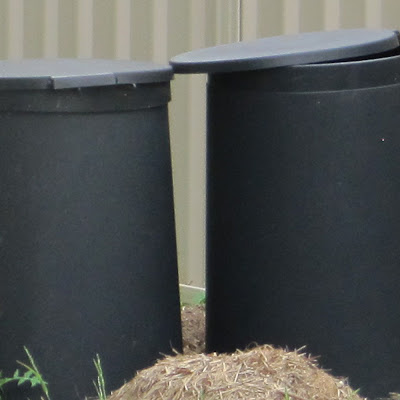Project Compost: Restart
 |
| Our sad compost bins. |
So the garden has been roundly neglected of late (more on this and what I'm doing to rectify the situation in a later post) and the poor old compost heap has seen many better days too. It was really flourishing pre-renovation, as I'd been working on it for about six months and had two big bins worth of garden gold almost ready to go. The little fairy wrens in the yard loved all the bugs that scattered every time I opened the lid and the willy wagtails were well pleased when I'd share some of the insects with them.Then the builders came in and knocked both bins down, spreading my compost all over the backyard, on day one of the reno.I get a really awful, wasteful feeling in the pit of my tummy every time I throw away food scraps (similar to the feeling I get using disposable nappies, truth be told) and I think about restarting the ol' compost bins - stat. Then life gets in the way, as usual, and the next time I think about it is when I'm tossing tonight's salad scraps in the bin.But no more. This week fortnight-ish I will buy some manures, chop some garden waste and start the bins again.I thought I could offer a very very basic rundown of how I build our compost bins, in case this is something you're interested in. Once it's set up, it really is a super simple way to cut down on your rubbish dramatically, and as a bonus you get the most beautiful plant food imaginable - for free!*NB There is a huge amount of information out there on composting. There are books and blogs and websites all dedicated to the science of it. I'm not offering any scientific advice here, just a basic overview of what I do at home. This is likely not best practice. Probably not even close. You need to get yourself two or three bins. Bunnings sell simple compost bins for around $30 each. These have a flip-top lid and an open bottom (the bottom needs to be open to allow worms and insects in, as well as allowing you to turn your heap easily). Place the bins somewhere they will stay pretty dry, and somewhere that makes depositing your scraps easy.To start, I buy a couple of bags of manure from a farm nearby. Any type will do really, but chook poo is good. I add a layer of this to the bottom of the bin, followed by some grass clippings, some garden cuttings (if these are in large pieces, try breaking them up or running the mower over them first), some hay and a bucket of kitchen scraps. I generally keep these layers to around 10cm deep each, with the exception of the dense grass clippings, 3-5cm will do there. I also make sure not to compact the layers down as composting requires lots of air.The compost bin has officially begun! I now add our kitchen scraps over the week, occasionally covering them with a handful of hay or leaves. Once the layer of scraps reaches around 10cm I start the layering all over again.After around a month or so I lift the whole bin off the pile and move it to one side, leaving the entire pile exposed. I then use my shovel and garden fork to work through the pile, separating any big chunks and aerating the whole lot. Then I shovel it all back into the bin. I keep adding, layering, moving and aerating until the bin is pretty much full, then I leave it alone for a while. Depending on the weather it may be three months, it may be more. Occasionally, if I remember, I may turn the pile to help speed things along and get an idea of how the compost is cooking.Once bin #1 is cooking, I start bin #2 using the same method. The theory being that once the compost in bin #1 is ready to use in the garden, bin #2 will be ready to cook. Then bin #3 is used for depositing scraps etc, while bin #1 stores the usable compost and bin #2 cooks away. In reality, the length of each stage varies and there will be times where you have two bins cooking and no usable compost.At this early stage in my gardening career I can't worry about that so much, only take pleasure in the knowledge that my scraps will be fertilising my garden sometime in the near future. Hopefully yours will too!!To stop this post from becoming any lengthier, I'll put together another post for later in the week that outlines the things you should and shouldn't compost in this type of pile.

